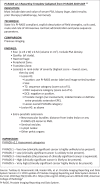PI-RADS v2.1: What has changed and how to report
- PMID: 34230862
- PMCID: PMC8252188
- DOI: 10.4102/sajr.v25i1.2062
PI-RADS v2.1: What has changed and how to report
Abstract
Multiparametric magnetic resonance imaging (MRI) of the prostate has become a vital imaging tool in daily radiological practice for the stratification of the risk of prostate cancer. There has been a recent update to the Prostate Imaging-Reporting and Data System (PI-RADS). The updated changes in PI-RADS, which is version 2.1, have been described with information pertaining to the recommended imaging protocols, the techniques on how to perform prostate MRI and a simplified approach to interpreting and reporting MRI of the prostate. Explanatory tables, schematic diagrams and key representative images have been used to provide the reader with a useful approach to interpreting and then stratifying lesions in the four anatomical zones of the prostate gland. The intention of this article is to address challenges of interpretation and reporting of prostate lesions in daily practice.
Keywords: PI-RADS; assessment categories to stratify risk; magnetic resonance imaging; prostate carcinoma; structured reporting; technical parameters for mpMRI of prostate.
© 2021. The Authors.
Conflict of interest statement
The authors declare that they have no financial or personal relationships that may have inappropriately influenced them in writing this pictorial review.
Figures











References
-
- Weinreb JC, Barentz JO, Choyke PL, et al. . PI-RADS Prostate Imaging-Reporting and Data System, v2.1 [homepage on the Internet]. American College of Radiology; 2019. [cited 2021 Mar 15]. Available from: https://www.acr.org/-/media/ACR/Files/RADS/Pi-RADS/PIRADS-V2-1.pdf
-
- World Cancer Research Fund International/American Institute for Cancer Research . Continuous Update Project Report. Diet, nutrition, physical activity, and prostate cancer [homepage on the Internet]. 2014. [cited 2015 Dec 01]. Available from: www.wcrf.org/sites/default/files/Prostate-Cancer-2014-Report.pdf
-
- Singh E, Motsuku L, Sengayi-Muchengeti M, Chen W, Abraham N. Ekurhuleni population-based registry 2018 Annual report. Johannesburg, South Africa, March 2020. National Health Laboratory Service, National Cancer Registry, Department of Health. Johannesburg; 2020.
Publication types
LinkOut - more resources
Full Text Sources
Research Materials
Miscellaneous
